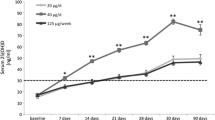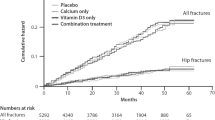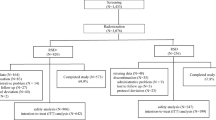Abstract
Summary
The aim of the the study is to compare the effects of cholecalciferol and calcitriol on bone mineral metabolism in women with vitamin D deficiency. Calcitriol was associated with a significant increase in bone mineral density at the lumbar spine in patients with low vitamin D levels.
Purpose/introduction
Active vitamin D analogs may have larger impact in decreasing bone loss and fracture rate compared to cholecalciferol in osteoporosis. However, their effects in the treatment of vitamin D deficiency compared to cholecalciferol are not clear. The aim of the present study is to compare the effects of cholecalciferol and calcitriol on bone mineral metabolism and bone mineral density in pre- and postmenopausal women with vitamin D deficiency.
Methods
This was a 6-month prospective, open-label, controlled clinical trial. Eligible 120 participants were pre- and postmenopausal women diagnosed with vitamin D deficiency. Forty-three subjects (group 1) received 1000 IU of cholecalciferol and 1 g of calcium daily. The other 77 subjects (group 2) received 0.5 μg calcitriol in addition to 400 IU of cholecalciferol and 1 g of calcium daily.
Results
Oral vitamin D supplementation did not increase bone mineral density after 6 months of intervention in group 1. On the other hand, bone mineral density at the lumbar spine increased from 0.809 ± 0.172 to 0.848 ± 0.161 g/cm2 in group 2 patients (p < 0.017 vs baseline).
Conclusions
Oral daily calcitriol was associated with a significant increase in bone mineral density at the lumbar spine in patients with low vitamin D, elevated PTH, and osteoporosis.


Similar content being viewed by others
References
Holick MF (2007) Vitamin D deficiency. N Engl J Med 357:266–281
Li X, Liao L, Yan X, Huang G, Lin J, Lei M, Wang X, Zhou Z (2009) Protective effects of 1-α-hydroxyvitamin D3 on residual beta-cell function in adult-onset latent autoimmune diabetes (LADA). Diabetes Metab Res Rev 25:411–416
Chapuy MC, Pamphile R, Paris E, Kempf C, Schlichting M, Arnaud S, Garnero P, Garnero P, Meunier PJ (2002) Combined calcium and vitamin D3 supplementation in elderly women: confirmation of reversal of secondary hyperparathyroidism and hip fracture risk: the Decalyos II study. Osteoporos Int 13(3):257–264
Harris ST, Watts NB, Genant HK, McKeever CD, Hangartner T, Keller M, Chesnut CH, Brown J, Eriksen EF, Hoseyni MS, Axelrod DW, Miller PD (1999) Effects of risedronate treatment on vertebral and nonvertebral fractures in women with postmenopausal osteoporosis. JAMA 282(14):1344–1352
Chesnut CH, Skag A, Christiansen C, Recker R, Stakkestad JA, Hoiseth A, Felsenberg D, Huss H, Gilbride J, Schimmer RC, Delmas PD, and for the oral ibandronate osteoporosis vertebral fracture trial in North America and Europe (Bone) (2004) Effects of oral ibandronate administered daily or intermittently on fracture risk in postmenopausal osteoporosis. J Bone Miner Res 19(8):1241–1249
Meunier PJ, Slosman DO, Delmas PD, Sebert JL, Brandi ML, Albanese C, Lorenc R, Pors-Nielsen S, De Vernejoul MC, Roces A, Reginster JY (2002) Strontium ranelate: dose dependent effects in established postmenopausal vertebral osteoporosis- a 2-year randomized placebo controlled trial. J Clin Endocrinol Metab 87:2060–2066
Lau KH, Baylink DJ (1999) Vitamin D therapy of osteoporosis: plain vitamin D therapy versus active vitamin D analog (D-hormone) therapy. Calcif Tissue Int 65:295–306
Bischoff-Ferrari HA, Borchers M, Gudat F, Dürmüller U, Stahelin HB, Dick W (2004) Vitamin D receptor expression in human muscle tissue decreases with age. J Bone Miner Res 19:265–269
Papadimitropoulos E, Wells G, Shea B (2002) Meta-analysis of the efficacy of vitamin D treatment in preventing osteoporosis in postmenopausal women. Endocr Rev 23:560–569
Dawson-Hughes B, Heaney RP, Holick MF, Lips P, Meunier PJ, Vieth R (2005) Estimates of optimal vitamin D status. Osteoporos Int 16:713–716
Genant HK, Jergas M, Palermo L et al (1996) Coomparison of semiquantitative visual and quantitative morphometric assessment of prevalent and incident vertebral fractures in osteoporosis. J Bone Miner Res 11:984–996
World Medical Association Declaration of Helsinki (2000) Ethical principles for medical research involving human subjects. JAMA 284:3043–3045
Zhang H, Huang Q, Gu J, HU W, Liu Y, Hu Y, Zhang Z (2012) Comparison of the effects of cholecalciferol and calcitriol on calcium metabolism and bone turnover in Chinese postmenopausal women with vitamin D insufficiency. Acta Pharmacol Sin 33(4):490–495
Bischoff-Ferrari HA, Willett WC, Wong JB, Giovannucci E, Dietrich T, Dawson Hughes B (2005) Fracture prevention with vitamin D supplementation: a meta-analysis of randomized controlled trials. JAMA 293:2257–2264
Binkley N, Novotny R, Krueger D, Kawahara TN, Daida YG, Gemar D, Lensmeyer GL, Hollis BW, Drezner MK (2007) J. Low vitamin D status despite abundant sun exposure. J Clin Endocrinol Metab 92:2130–2135
Holick MF, Siris ES, Binkley N, Beard MK, Khan A, Katzer J, Petruschek RA, Chen E, dePapp AE (2005) Prevalence of Vitamin D inadequacy among postmenopausal North American women receiving osteoporosis therapy. J Clin Endocrinol Metab 90: 3215–24
Seeman E, Delmas PD (2006) Bone quality-the material and structural basis of bone strength and fragility. N Engl J Med 354:2250–2261
Ringe JD, Schacht E (2004) Prevention and therapy of osteoporosis: the roles of plain vitamin D and alfacalcidol. Rheumatol Int 24:189–197
Tsukamoto Y, Watanabe T, Nakagami T, Morishita K (2003) Effect of treatment with oral calcitriol on calcium metabolism and fasting serum 25OH-or 1,25(OH)2 vitamin D level in Japanese postmenopausal women. Endocr J 50:681–687
Gurlek A, Pittelkow MR, Kumar R (2002) Modulation of growth factor/cytokine synthesis and signalling by 1alpha,25dihydroxyvitamin D3: implications in cell growth and differentiation. Endocr Rev 23:763–786
Sibata T, Shira-Ishi A, Sato T, Masaki T, Sasaki A, Masuda Y et al (2002) Vitamin D hormone inhibits osteoclastogenesis in vivo by decreasing the pool of osteoclast precursors in bone marrow. J Bone Miner Res 17:622–629
Dobnig H (2011) A review of the health consequences of the vitamin D deficiency pandemic. J Neurol Sci 311(1–2):15–18
Clements MR, Davies M, Hayes ME, Hickey CD, Lumb GA, Mawer EB et al (1992) The role of 1,25-dihydroxyvitamin D in the mechanism of acquired vitamin D deficiency. Clin Endocrinol. Oxf 37:17–27
Halloran BP, Bikle DD, Levens MJ, Castro ME, Globus RK, Holton E (1986) Chronic 1,25-dihydroxyvitamin D3 administration in the rat reduces the serum conentration of 25-hydroxyvitamin D by increasing metabolic clearance rate. J Clin Invest 78:622–628
Harwood RH, Sahota O, Gaynor K, Masud T, Hosking DJ (2004) A randomised controlled comparison of different calcium and vitamin D supplementation regimens in elderly women after hip fracture: the Nottingham neck of femur (NoNOF) study. Age Ageing 33:45–51
Richy F, Ethgen O, Bruyere O, Reginster J-Y (2004) Efficacy of alfacalcidol and calcitriol in primary and corticosteroid-induced osteoporosis: a meta-analysis of their effects on bone mineral density and fracture rate. Osteoporos Int 15(4):301–310
Gallagher JC (2004) The effects of calcitriol on falls and fractures and physical performance tests. J Steroid Biochem Mol Biol 89-90:497–501
Schacht E, Richy F, Reginster J-Y (2005) The therapeutic effects of alfacalcidiol on bone strength, muscle metabolism and prevention of falls and fractures. J Musculoskelet Neuronal Interact 5(3):273–284
Richy F, Dukas L, Schacht E (2008) Differential effects of D-hormone analogus and native vitamin D on the risk of falls: a comparative meta-analysis. Calcif Tissue Int 82:102–107
Shane E, Adesso V, Namerow PB, McMahon DJ, Lo SH, Staron RB, Zucker M, Pardi S, Maybaum S, Mancini D (2004) Alendronate or calcitriol and prevention of bone loss after cardiac transplantation. N Engl J Med 350(8):767–776
Frediani B, Allegri A, Bisohno S, Marcolongo R (1998) Effects combined treatment with calcitriol plus alendronate on bone mass and bone turnover in postmenopausal osteoporosis. Two years of continuous treatment. Clin Drug Invest 14:235–244
Hermann M, Widmann T, Colaianni G, Colucci S, Zallone A, Hermann W (2005) Increased osteoclastic activity in the presence of increased homocysteine concentrations. Clin Chem 51:2348–2353
Hubmacher D, Sabatier L, Annis DS, Mosher DF (2011) Reinhardt DP. Homocysteine modifies structural and functional properties of fibronectin and interferes with the fibronectin-fibrillin-1 interaction. Biochemistry 50:5322–5332
Calo L, Castrignano R, Davis PA, Carraro G, Pagnin E, Giannini S, Semplicini A, D’Angelo AA (2000) Role of insulin-like growth factor-I in primary osteoporosis: a correlative study. J Endocrinol Investig 23:223–227
Boonen S, Mohan S, Dequeker J, Aerssens J, Vanderschueren D, Verbeke G, Broos P, Bouillon R, Baylink DJ (1999) Down-regulation of the serum stimulatory components of the insulin-like growth factor (IGF) system (IGF-I, IGF-II, IGF binding protein (BP)-3 and IGFBP-5) in age related (type II) femoral neck osteoporosis. J Bone Miner Res 14:2150–2158
Li J, Jih D, Fu S, Mei G, Zhou J, Lei L, Yu B, Wang G (2013) Insulin -like growth factor binding protein-3 modulates osteoblast differentiation via interaction with vitamin D receptor. Biochem Biophys Res Commun 436:632–637
Funding
Refik Tanakol declares no competing financial interest and certifies that no funding has been received for the conduct of this study and/or preparation of this manuscript.
Nurdan Gül declares no competing financial interest and certifies that no funding has been received for the conduct of this study and/or preparation of this manuscript.
Ayşe Kubat Üzüm declares no competing financial interest and certifies that no funding has been received for the conduct of this study and/or preparation of this manuscript.
Ferihan Aral declares no competing financial interest and certifies that no funding has been received for the conduct of this study and/or preparation of this manuscript.
Author information
Authors and Affiliations
Corresponding author
Ethics declarations
This study was conducted in full compliance with the principles of the Declaration of Helsinki. Ethical approval was obtained from Ethics Committee of Istanbul Faculty of Medicine (Dean’s approval and Ethics Committee ref. No. 467 70954-700-2017-551) [12]. Written informed consent for participation was obtained from participants or, where participants are children, a parent or guardian.
Conflict of interest
None.
Rights and permissions
About this article
Cite this article
Tanakol, R., Gül, N., Üzüm, A.K. et al. Calcitriol treatment in patients with low vitamin D levels. Arch Osteoporos 13, 114 (2018). https://doi.org/10.1007/s11657-018-0529-2
Received:
Accepted:
Published:
DOI: https://doi.org/10.1007/s11657-018-0529-2




